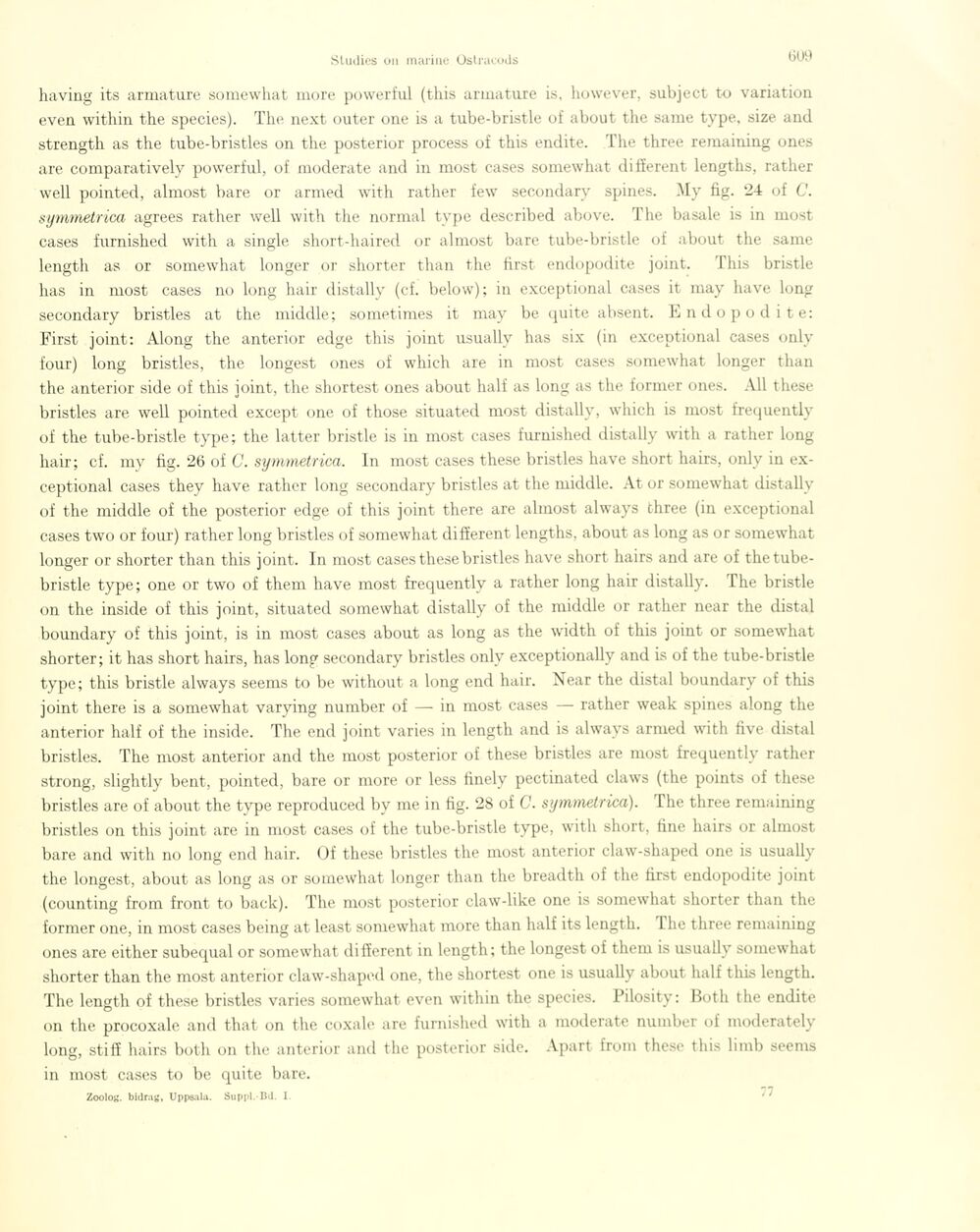
Full resolution (JPEG) - On this page / på denna sida - Sidor ...

<< prev. page << föreg. sida << >> nästa sida >> next page >>
Below is the raw OCR text
from the above scanned image.
Do you see an error? Proofread the page now!
Här nedan syns maskintolkade texten från faksimilbilden ovan.
Ser du något fel? Korrekturläs sidan nu!
This page has never been proofread. / Denna sida har aldrig korrekturlästs.
having its armature somewhat more powerful (this armature is, however, subject to variation
even within the species). The next outer one is a tube-bristle of about the same type, size and
strength as the tube-bristles on the posterior process of this endite. The three remaining ones
are comparatively powerful, of moderate and in most cases somewhat different lengths, rather
well pointed, almost bare or armed with rather few secondary spines. My fig. 24 of C.
symmetrica agrees rather well with the normal type described above. The basale is in most
cases furnished with a single short-haired or almost bare tube-bristle of about the same
length as or somewhat longer or shorter than the first endopodite joint. This bristle
has in most cases no long hair distally (cf. below); in exceptional cases it may have long
secondary bristles at the middle; sometimes it may be quite absent. Endopodite:
First joint: Along the anterior edge this joint usually has six (in exceptional cases only
four) long bristles, the longest ones of which are in most cases somewhat longer than
the anterior side of this i oint, the shortest ones about half as long as the former ones. AU these
bristles are well pointed except one of those situated most distally, which is most frequently
of the tube-bristle type; the latter bristle is in most cases furnished distally with a rather long
hair; cf. my fig. 26 of G. symmetrica. In most cases these bristles have short hairs, only in
exceptional cases they have rather long secondary bristles at the middle. At or somewhat distally
of the middle of the posterior edge of this joint there are almost always three (in exceptional
cases two or four) rather long bristles of somewhat different lengths, about as long as or somewhat
longer or shorter than this joint. In most cases these bristles have short hairs and are of the
tube-bristle type; one or two of them have most frequently a rather long hair distally. The bristle
on the inside of this joint, situated somewhat distally of the middle or rather near the distal
boundary of this joint, is in most cases about as long as the width of this joint or somewhat
shorter; it has short hairs, has long secondary bristles only exceptionally and is of the tube-bristle
type; this bristle always seems to be without a long end hair. Near the distal boundary of this
joint there is a somewhat varying number of — in most cases — rather weak spines along the
anterior half of the inside. The end joint varies in length and is always armed with five distal
bristles. The most anterior and the most posterior of these bristles are most frequently rather
strong, slightly bent, pointed, bare or more or less finely pectinated claws (the points of these
bristles are of about the type reproduced by me in fig. 28 of C. symmetrica). The three remaining
bristles on this joint are in most cases of the tube-bristle type, with short, fine hairs or almost
bare and with no long end hair. Of these bristles the most anterior claw-shaped one is usually
the longest, about as long as or somewhat longer than the breadth of the first endopodite joint
(counting from front to back). The most posterior claw-like one is somewhat shorter than the
former one, in most cases being at least somewhat more than half its length. The three remaining
ones are either subequal or somewhat different in length; the longest of them is usually somewhat
shorter than the most anterior claw-shaped one, the shortest one is usually about half this length.
The length of these bristles varies somewhat even within the species. Pilosity: Both the endite
on the procoxale and that on the coxale are furnished with a moderate number of moderately
long, sti ff hairs both on the anterior and the posterior side. Apart from these this limb seems
in most cases to be quite bare.
Zoolog. bidrag, Uppsala. Suppl.-Bd. I
<< prev. page << föreg. sida << >> nästa sida >> next page >>